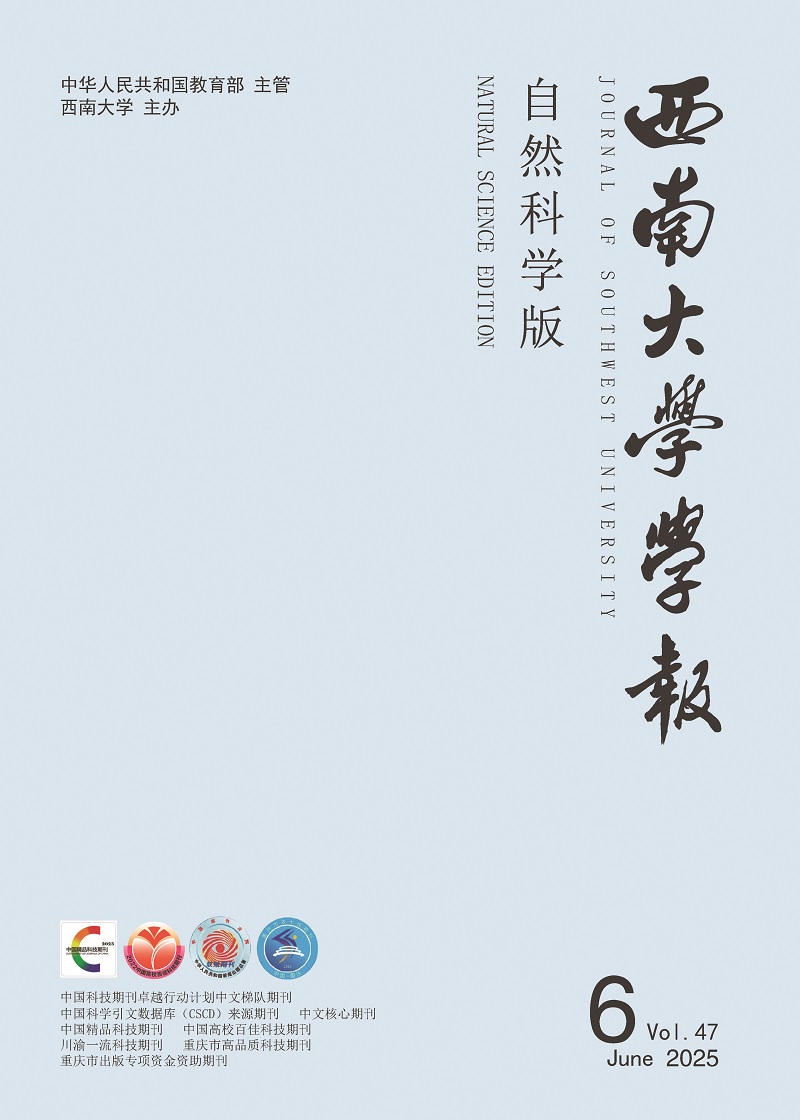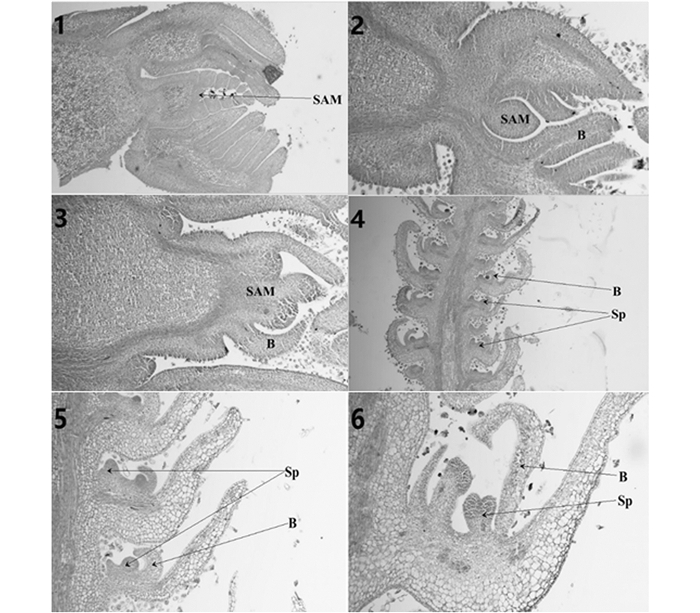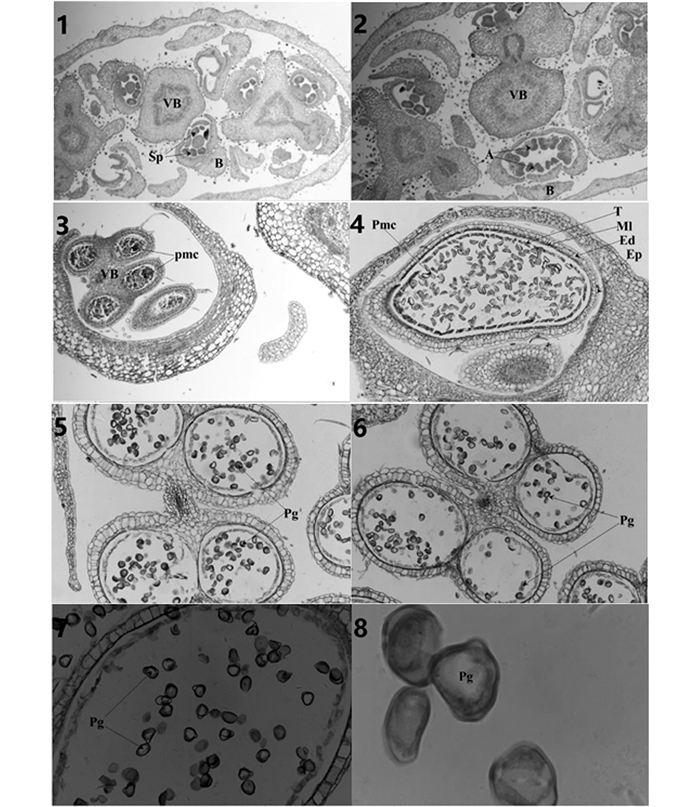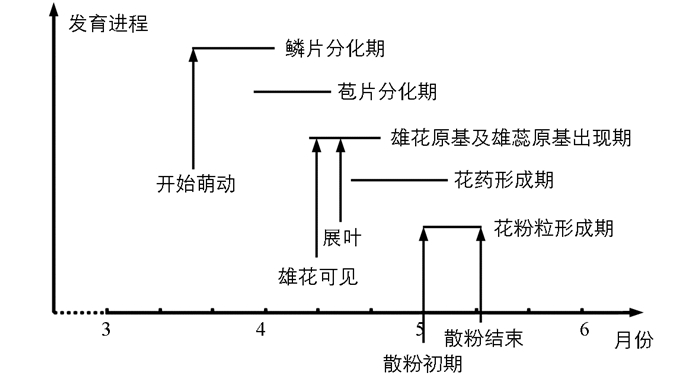-
薄壳山核桃(Carya illinoensis (Wangench.) K.Koch)是雌雄同株异花授粉植物,属胡桃科(Julandaceae)山核桃属(Carya Nutt),其干形通直高大,常用于园林绿化及大型建材[1-2],果仁营养丰富,颗粒饱满、壳薄味香,不饱和脂肪酸含73%,可直接食用也可作为糕点面包等的添加材料[3-5],市场潜力巨大.
果实产量与品质的高低直接受花芽分化的影响[6],大多数薄壳山核桃品种为雌先型,雌花的可授粉期与雄花的散粉期多不一致,造成薄壳山核桃果用林分产量不稳,大小年变化显著[7].针对这一问题,姚小华等[8]研究了薄壳山核桃的物候开花习性,为种植园品种搭配提供了理论依据,杨先裕等[9]通过物候期观察方法得出浙江建德薄壳山核桃雄蕊花萼在4月26日开裂,5月初散粉.在花芽分化解剖学研究方面,黄有军等[10]将山核桃(Caryacathayensis Sarg.)雄花芽发育自3月下旬至5月上旬分为雄蕊形成期、花药形成期、花粉粒形成与发育3个时期,李永涛等[11]将早实核桃雄花发育详细划分为雄花形态分化临界期、雄花花序原基分化期、雄花原基分化期、苞片原基分化期、花药分化期、花粉囊和花粉粒形成期,但有关薄壳山核桃雄花发育的形态学方面研究还未见报道.本文选取目前主要栽培品种Mahan为研究对象,采用石蜡切片法,对其雄花发育过程进行解剖学研究,建立雄花芽发育外部特征与内部显微结构之间的关系,以期为薄壳山核桃品种配置及人工辅助授粉提供参考.
HTML
-
实验取样地位于浙江省建德市更楼街道洪宅村,为5株小区3次重复,地理位置119°18′21″E,29°34′42″N,海拔100 m,坡度25°,年平均温度16.9 ℃,无霜期254 d,年均降雨量1 500 mm,日照充足,年均日照总时数1 760 h,土壤为紫砂土,属中亚热带北缘季风气候带,实验地每年进行常规抚育管理.
-
选择立地条件、生长状况较为一致的、健壮、无病虫害的12年生薄壳山核桃品种马罕(Mahan)为实验材料,从2016年3月15日至6月1日每隔3~5 d取样1次,每次剪取10~15个试材外围中部枝条,装入自封袋内后立即放置于冰袋泡沫箱中带回实验室.从中取出15~20个花芽用FAA固定,取样标准为结果母枝形态学下端第1~4个芽,固定时间24 h以上,制作石蜡切片,石蜡切片的制作参照叶创兴等[12]的方法,经脱水、透明、浸蜡、包埋、切片(Thermo HM 325切片机)、番红固绿染色、中性树胶封片等步骤制成切片(厚度7~8μm),Nikon DS-Ri2荧光显微镜镜检和拍摄.其余花芽用游标卡尺测量长度和宽度后置于-80 ℃的低温冰箱中保存,用于对比外部特征变化.
1.1. 实验地概况
1.2. 材料与方法
-
根据研究,薄壳山核桃雄花芽的发育过程大致可分为6个阶段:分化初期、鳞片分化、苞片分化、雄花原基及花被分化、雄蕊原基出现、花药分化形成.雄花为三出柔荑花序,多生于短枝状混合裸芽中下部.雄花芽于上一年开始分化,12月下旬分化停止,当年春继续分化.
分化初期:经过冬季休眠,在3月中下旬Mahan薄壳山核桃开始萌芽,部分侧芽进入雄花芽分化状态,由于雄花芽与侧叶芽为同源器官,早期难以分辨出叶芽和雄花芽(图 1-1).
鳞片分化:3月下旬随着气温进一步回升,Mahan的花序基部逐渐形成突起,开始鳞片化阶段(图 1-2).
苞片分化:4月上旬新稍伸长,侧芽于叶腋间显现,雄花芽和叶芽可明显分辨出,雄花序四周自下而上逐渐分化出弯月形苞片,包裹整个花序,芽体呈塔形,花序顶部呈馒头状[10](图 1-3).
雄花原基及花被分化:4月中旬随着雄花序进一步分化,自上而下由苞片基部逐渐形成突起状雄花原基(图 1-4,图 1-5,图 2-1).
雄蕊原基出现:4月下旬,在雄花原基顶部形成雄蕊原基,随后雄蕊突起发育柱状体雄蕊,花被向内弯曲包裹着雄蕊,而苞片又从雄花基部伸出,伸向花被外围,雄蕊原基进一步分化,产生花药(图 1-6,图 2-2).
花药分化形成:4月下旬至5月上旬,花药继续分化,形成具有4个花粉囊的花药(图 2-3).此时花粉囊壁明显分为药室内壁、中层和绒毡层3部分(图 2-4).药室内壁细胞略大于表皮细胞,呈长条状,随后药室内壁细胞径向生长,外侧细胞壁变薄,内侧细胞壁带状加厚(图 2-5).中层细胞不断增大,在花粉形成中被消耗吸收并最终消失(图 2-6).绒毡层细胞体积随花粉发育逐渐变小,最终留下呈带状细胞残迹(图 2-7). 5月初花药发育成熟,中层和绒毡层消失,随后花粉囊开裂,大量花粉散出(图 2-8).
-
薄壳山核桃雄花芽发育过程中,外部形态特征与内部花芽发育具有一定的相关性,通过外部形态的观察和内部解剖结构的对比,有利于了解不同发育阶段的相关性,对各个时期薄壳山核桃的外部记录,对照内部解剖结构,进行相关描述(表 1).
2.1. 薄壳山核桃雄花芽分化时期及主要特征
2.2. 外部形态与解剖结构之间的对应关系
-
薄壳山核桃花芽分化是一个连续过程,各相邻分化时期可能存在一定的重叠现象.本研究结果表明,薄壳山核桃品种马罕(Mahan)雄花芽发育过程从3月中下旬开始到5月上旬基本完成,整个过程包括:分化初期(3月中下旬)、鳞片分化(3月下旬)、苞片分化(4月上旬)、雄花原基分化(4月中旬)、雄蕊原基出现(4月下旬)、花药分化形成(4月下旬至5月上旬)6个阶段(图 3),其花芽分化基本与荣瑞芬等[13]、黄有军等[10]的报道相似,但是,自鳞片分化以后的各发育阶段时间均比他们所述的要稍早一些,且各个花器的分化始期、间隔时间也不规律.黄有军等[10]对浙江临安山核桃花芽分化进程的研究指出,山核桃雄蕊在3月下旬至4月中旬形成,花药在4月中旬至5月上旬形成,并且划分出花粉粒的形成期为4月下旬,花粉粒的发育期为4月下旬至5月上旬.荣瑞芬等[13]对河北保定地区山核桃花芽发育进程的研究表明,4月上旬至4月下旬为鳞片分化期,4月下旬为苞片分化期,4月下旬至5月初为雄花原基分化期,而5月中旬至6月初为花被及雄蕊发育完成期.这说明品种和环境条件的不同可能会导致薄壳山核桃花芽发育进程的不同.
多数研究结果认为花芽分化过程中外部形态特征与内部解剖结构之间存在一定的相关性[14],本文建立了薄壳山核桃雄蕊发育的外部形态与解剖结构之间的对应关系,这为花芽分化、人工授粉等相关研究的适时取材提供了科学依据.









 DownLoad:
DownLoad: